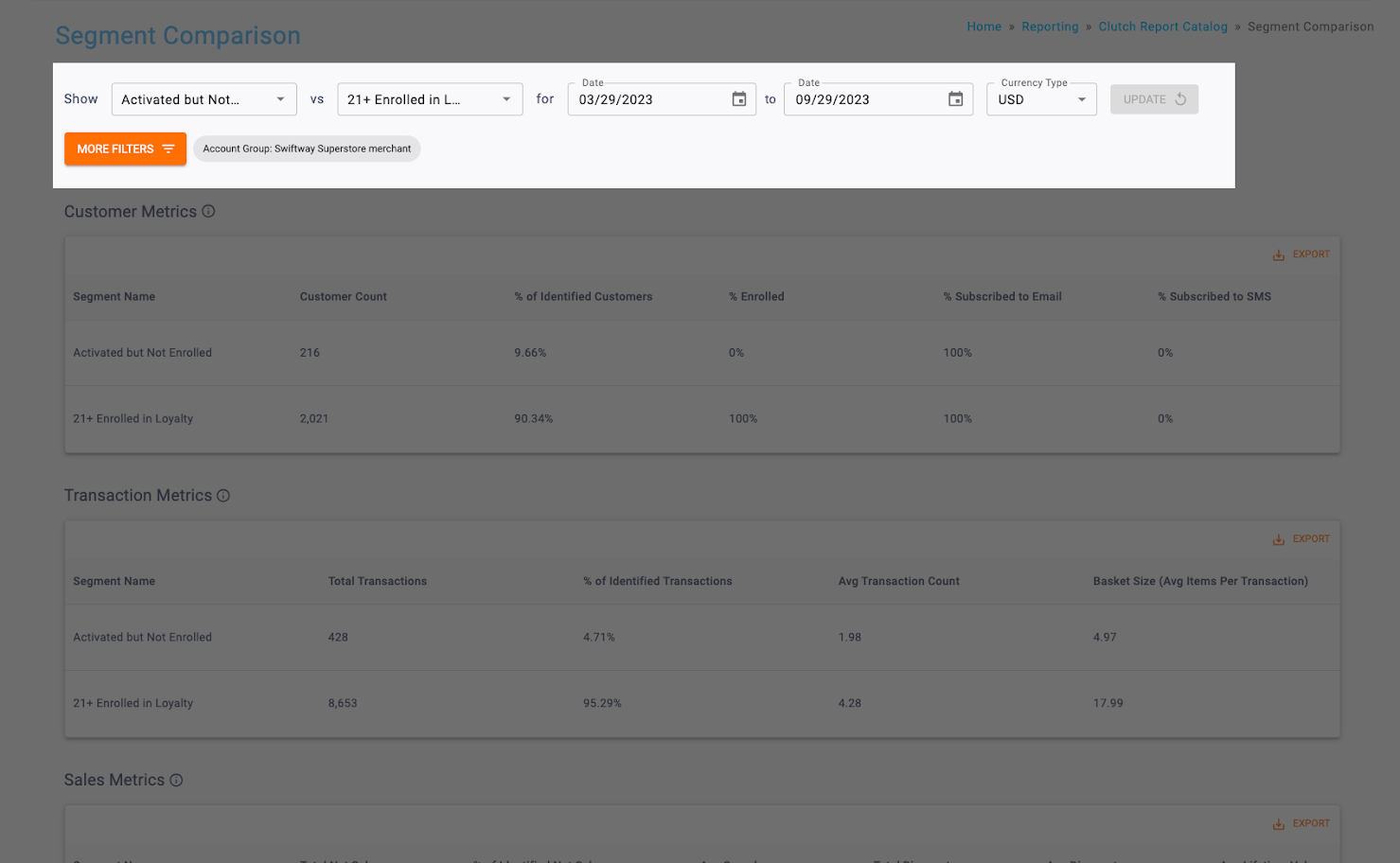The Segment Comparison Report can be found in the Reporting section of the Clutch Portal. This report allows you to view and compare customer, transaction, and sales metrics between segments.
This report will appear blank until you select a Segment to show from the dropdown and click the Update button.
Be sure you have an Account Group selected or applied to your user in order to view all of the reports. You can click within each section to learn more about each aspect of the report.
Filters
You’ll be able to target specific data within your report by using the available filters on top. These filters include:
This allows you to select a Segment to compare against All Others or another specific Segment. “All Others” is the default for the second segment selection. All Others refers to all other identified cards.
While looking at a Segment vs All Others will capture all of your identified cards, looking at a Segment vs Segment may not. Segments are not mutually exclusive, so there can be overlap between.
This allows you to filter based on the transaction date. You can select start and end dates. Note that the default for this is the last 6 months.
All dates are specific to the brand’s reporting time zone that is configured in their brand settings.
- Start Dates begin as of 12:00:00AM of the chosen date.
- End Dates end as of 11:59:59PM of the chosen date.
This allows you to filter based on the currency type of the location where the transaction occurred. USD is the default unless your brand does not have any USD locations.
This button opens a drawer to give the user a list of additional optional filters to apply to the report, including Location, Segment, Transaction Type, Order Mode, and Revenue Center.
Although you may be able to see all of these filters, they may not all apply to your brand. This just depends on how your brand data is configured.
Note that if your user has a Group and/or Location applied in the Account menu, the data may be filtered to that specific Group and/or Location. If these filters have been applied to the report you are viewing, you will see them in the More Filters section.
Once you have the filters you want in place, click the Update button to update your report.

Report Table: Customer Metrics
These metrics are based on the non-filtered current segment membership; all cards that meet the segment criteria at the time that the report is being viewed. You can view the following information in the columns of this table:
This shows the name of the segment.
This shows how many customers meet the segment criteria.
This shows the Customer Count of the segment divided by your total activated card count.
This shows the percentage of the Customer Count of the segment that is currently enrolled in loyalty.
This shows the percentage of the Customer Count of the segment that is currently opted in to email.
This shows the percentage of the Customer Count of the segment that is currently opted in to mobile messaging.
Report Table: Transaction Metrics
These metrics are based on the filtered historical performance of the current segment membership. You can view the following information in the columns of this table:
This shows the name of the segment.
This shows the total purchases minus voids.
This shows the Total Transactions of the segment divided by Total Transactions for all identified cards that meet the filter criteria.
This shows the Total Transactions divided by Customer Count.
This shows the total number of purchase items divided by the Total Transactions.
Note: The table results can be downloaded as a CSV using the Export button. Table columns can be temporarily rearranged by holding a click on the column header and dragging to the left or right. These changes are passed through to the Export and reset when the page is reloaded.
Report Table: Sales Metrics
Note that these metrics are based on the filtered historical performance of the current segment membership. You can view the following information in the columns of this table:
This shows the name of the segment.
This shows the total amount minus voids and discounts.
This shows the Total Net Sales of the segment divided by Total Net Sales for all identified cards that meet the filter criteria.
Toggle
This shows Total Net Sales divided by Customer Count.
This shows the total amount of discount that has been applied to transactions.
This shows Total Discount divided by Customer Count.
This shows Lifetime Value divided by Customer Count. The calculation for this is AOV multiplied by Purchases in a year multiplied by average years of the customer’s relationship. The average years of relationship is a brand setting and is defaulted to 6. Note that only customer activity that meets the applied filter criteria for the report will be included in this calculation. To learn more about Customer Lifetime Value, you can read the article here.
Note: The table results can be downloaded as a CSV using the Export button. Table columns can be temporarily rearranged by holding a click on the column header and dragging to the left or right. These changes are passed through to the Export and reset when the page is reloaded.
Percent of Identified Charts
These metrics are based on the filtered historical performance of the current segment membership. You can view the following information in the columns of this table:
These charts compare the two selected segments to show how make up the percent of total for Identified Customers, Identified Transactions, and Identified Net Sales.
Note: Viewing a Segment vs All Others will always add up to 100%, but viewing a Segment vs Segment can add up to less than or more than 100%. Segments are not mutually exclusive or all-inclusive, so the two groups could overlap between them or not capture all of your identified cards.

